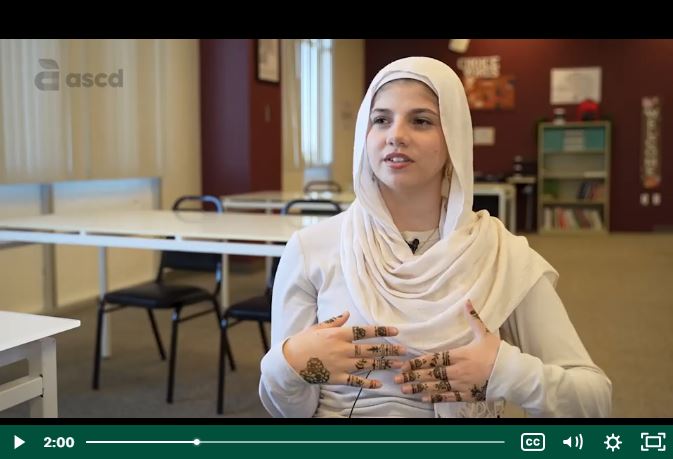What is belonging? According to Cornell University’s Department of Diversity, Inclusion, and Belonging, belonging is ‘the feeling of security and support when there is a sense of acceptance, inclusion, and identity for a member of a certain group.’ In school communities, belonging occurs when individuals can bring their authentic selves into the learning environment. When students, teachers, and staff feel a sense of belonging, they thrive in a learning community that embraces diverse backgrounds and life experiences. Belonging impacts performance significantly and is a critical factor in enhancing engagement and achievement across social, emotional, cognitive, physical, and behavioral domains at home, in school, and in the broader community.
Survey Insights: Kent ISD’s Approach
Within Kent County, schools and districts taking the MI Student Perception survey measure belongingness by assessing how strongly students feel they belong in school, how well they perceive others understand them, and the extent to which students feel connected to their peers. Our students’ holistic experiences and well-being beyond test scores are the focus of this anonymous survey. It aims to comprehend students’ perceptions of belonging, social and emotional learning, and engagement. While participation in the survey is voluntary, robust data collection efforts facilitate informed decision-making. Recognizing and fostering a culture of belonging is the cornerstone of an effective teaching and learning process, ultimately enhancing students’ educational experiences.
- In 2023, 58 districts participated, a 190% increase from 2022.
- The number of surveyed students also saw a substantial rise, with 33,366 students participating in the survey, reflecting a 176% increase from the previous year.
- Statewide spring 2023 survey results indicate that, on average, elementary students experience a greater sense of belonging than high school students.

Importance of Cultural Awareness
Cultural awareness and relationships are top priorities when cultivating a culture of belonging. In fact, according to these survey results, students across all grade levels—elementary, middle, and high school—indicate a lack of meaningful opportunities where educators consistently develop an understanding of culture.
These survey findings suggest two potential scenarios:
1) educators are aware of their own culture and how it has shaped their own beliefs, values, and perceptions. Yet, the self-work of investigating biases is lacking, limiting the examination of differing cultural traditions, languages, values, beliefs, norms, symbols, foods, work ethic, economic systems, etc.,
Or 2) educators need to be made aware of how their culture shapes their beliefs, values, and perceptions, leading to a lack of understanding of the importance of students’ cultural awareness.
Why is it important to be aware of and understand culture? Educators who possess cultural awareness can gain a deep understanding of their own culture and themselves. Additionally, educators can authentically connect and relate to their socially, culturally, linguistically, and economically diverse learners and families. Deeper cultural connections. Deeper understanding.
Factors Influencing Belonging
“Belonging can’t be left to chance: When we center it in our work, the social capital of the entire school community grows.”
(Fisher, Frey, 2024)
Unlock the power and value of belonging. A recent article by Douglas Fisher and Nancy Frey (2024) explores the many dimensions of belonging in schools. In this powerful video, they asked students and educators what it means to belong and what it feels like to belong. Ultimately, they identified the following factors: welcomed, invited, present, known, accepted, involved, heard, supported, befriended, needed, and loved (Carter, 2021, figure 1). Consider the indicators of each of these factors for students and educators.
Geoffrey L. Cohen’s (2022) book, Belonging: The Science of Creating Connection and Bridging Divides, provides inspiration and hope. Drawing on the groundbreaking scientific research of his own and others, Cohen (2022) suggests this definition of belonging: “Belonging is the feeling that we’re part of a larger group that values, respects, and cares for us—and to which we feel we have something to contribute.” When establishing these spaces of belonging for students and educators, we highlighted vital aspects:
- Belonging is a feeling – once recognized and experienced, you know.
- Specific behaviors, attitudes, and rewards by a larger group demonstrate belonging.
- The feeling of belonging propels us to contribute to that larger group individually, uniquely, and admirably.
Adding to this sentiment, Google’s Chief Diversity Officer, Melonie D. Parker, paints a picture of hope. In her recent TED Talk: Advice for Leaders on Creating a Culture of Belonging, Parker (2023) boldly explains why “diversity, equity, and inclusion is insufficient without belonging…deeming it as a requirement, not an entitlement.” Educators must consciously aim to provide a shift in mindset. We can no longer settle for fitting in. It is essential to demonstrate recognition and thoughtfulness of additive thinking, approaching a teaching and learning space by breaking down complex concepts into manageable components. Reimagining spaces of belonging as breakthroughs and possibilities for creativity, connection, synthesis, innovation, and collaboration. Parker (2023) assures us that “it’s not about who fits in the culture, it’s [about asking ourselves] what is missing in the culture and [determining who or what needs to be added] in the culture.”
Actionable Steps for Fostering Belonging
Cohen (2022) offers these small but mighty long-lasting actionable steps in fostering a sense of belonging:
- Encourage yourself and your colleagues to self-reflect on your/their core values.
- Engage in self-work before confronting challenges.
- Engross yourself in self-work before expressing the belief in an individual’s capacity to rise to high expectations.
- Seek to learn about various cultures to boost your knowledge and understanding.
- Make the most of your time with students, families, colleagues, and community.
Additionally, Parker (2023) recommends these practical steps to promote a lasting sense of belonging:
- Normalize a deep understanding of underserved socially, culturally, linguistically, and economically diverse communities.
- Desire dignity, fairness, respect, and belonging in all teaching and learning environments.
- Unapologetically stand firm; do not retract. Move forward together.
Enriching Learning Opportunities: Spark Literacy, Implicit Bias Training, and More
To elevate belonging in our classrooms, don’t miss the Spark Literacy, Ignite Engagement: A Learning Lab Experience on March 13th. Limited seats are available for this exclusive event, where you’ll witness firsthand how Appleview Elementary has transformed its classroom dynamics to foster belonging. In Kent County, schools actively measure belongingness through surveys, underlining the importance of cultural awareness and relationships. Please save the date for the upcoming Implicit Bias webinars on March 7th and March 19th, offering valuable growth opportunities for educators to deepen their understanding and enhance cultural competence. By embracing these initiatives and fostering connections within our community, we can cultivate an inclusive environment where everyone feels valued and supported. Let’s approach connections with a yearning to learn more about each other and ourselves, collectively building a culture of belonging.
#StudentSuccess #InclusiveEducation #BelongingMatters #DiversityInSchools #EducationalEquity #KentISDpd #WeLeadLearning
This blog post was written by Sheree Joseph-Bos, Diversity, Equity, and Belonging Consultant for Kent ISD and edited by Amanda Walma, T/L Marketing and Communications Specialist for Kent ISD.
References:
- ASCD. Show & Tell: Belonging in Schools. (2024). Retrieved from: https://www.ascd.org/videos/show-and-tell-february-2024-belonging-in-schools
- Carter, E. W. (2021). Dimensions of Belonging for Individuals with Intellectual and Developmental Disabilities. In J. L. Jones & K. L. Gallus (Eds.), Belonging and Resilience in Individuals with Developmental Disabilities (pp. 13–33). Springer Nature.
- Cohen, G. L. (2022). Belonging: The Science of Creating Connection and Bridging Divides. Norton.
- Cornell University. (2023). Belonging at Cornell. Retrieved from: https://diversity.cornell.edu/belonging/sense-belonging
- Fisher, D., & Frey, N. (2024). What Does It Mean to Belong? ASCD. Retrieved from: https://www.ascd.org/el/articles/what-does-it-mean-to-belong
- MI Student Voice. (2023). Spring Survey Results. Retrieved from: https://mistudentvoice.org/results/spring-2023-survey-results/
- Parkview Elementary’s Equity and Belonging Committee.
- Parker, M.D. (2023). Advice for Leaders on Creating a Culture of Belonging: TED Talk. Retrieved from: https://www.ted.com/talks/melonie_d_parker_advice_for_leaders_on_creating_a_culture_of_belonging?language=en


